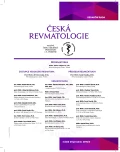Musculoskeletal involvement in patients with lysosomal storage disease
Authors:
J. Májovská 1; V. Malinová 1; G. Dostálová 2; Lenka Murgašová 1,3; H. Poupětová 1; J. Zeman 1; M. Magner 1,4
Authors‘ workplace:
Klinika dětského a dorostového lékařství 1. LF UK a VFN, Praha
1; Centrum pro Fabryho chorobu II. interní kliniky kardiologie a angiologie 1. LF UK a VFN, Praha
2; Klinika ušní, nosní a krční 2. LF UK a FN Motol, Praha
3; Pediatrická klinika 1. LF UK a Thomayerovy nemocnice, Praha
4
Published in:
Čes. Revmatol., 27, 2019, No. 4, p. 204-210.
Category:
Review Article
Overview
Lysosomal storage diseases (LSD) represent a heterogeneous group of > 60 severe hereditary metabolic disorders due to impaired function of one or more lysosomal enzymes or disorders of protein processing and transport across the lysosomal membrane. The diagnosis of LSD is based on clinical suspicion and the results of enzymatic and molecular analyses.
Of the 836 LSD patients diagnosed in the last 30 years, mucopolysaccharidoses (n = 150), Gaucher disease (n = 57), and Fabry disease (74 hemizygous men and 116 heterozygous women) were the most common. Initial symptoms of LSD that were initially diagnostically non-specific included swelling and limited mobility of large and/or small joints, knee and hip pain, joint disfiguration and bone deformity, hepatomegaly and/or splenomegaly, recurrent upper respiratory tract infections, obstructive and/or restrictive pulmonary disorder, decreased renal function, anemia and, in some types of LSD, growth disorders, craniofacial dysmorphia and cognitive impairment. Patients went through a number of specialist outpatient clinics including rheumatology, orthopedics, ENT, neurology, nephrology or hematology, which in most cases led to late diagnosis. Although individual types of LSD are rare, many are treatable or at least therapeutically modifiable. Enzyme replacement therapy (ERT), substrate reducing therapy (SRT), and hematopoietic stem cell transplantation are useful in therapy, which can significantly improve disease prognosis or at least stabilize its progression.
Conclusion: The efficacy of treatment in patients with lysosomal storage diseases is significantly dependent on early diagnosis, in which rheumatology specialists should participate as well.
Keywords:
lysosomal storage diseases – mucopolysaccharidoses – Gaucher disease – Fabry disease – musculoskeletal involvement
Sources
1. Mozolova D, Dallos T. Detská reumatologia v obrázkoch. Bratislava: Solen 2013.
2. Malinová V, Honzík T. Lysosomální onemocnění – současné možnosti diagnostiky a terapie. Pediatr praxi 2013; 14 : 99–103.
3. Magner M, Kulhánek J, Zeman J. Enzymová substituční terapie pacientů s mukopolysacharidózami. Remedia 2016; 4 : 356–361.
4. Honzík T, Zeman J, a kol. Dědičné poruchy metabolismu v kazuistikách. Praha: Mladá fronta 2016.
5. Poupětová H, Ledvinová J, Berná L, Dvořáková L, Kožich V, Elleder M. The birth prevalence of lysosomal storage disorders in the Czech Republic: comparison with data in different populations. J Inherit Metab Dis 2010; 33 : 387–396.
6. Dostalova G, Hlubocka Z, Lindner J, Hulkova H, Poupetova H, Vlaskova H, et al. Late diagnosis of mucopolysaccharidosis type IVB and successful aortic valve replacement in a 60-years-old female patient. Cardiovasc Pathol 2018; 35 : 52–56.
7. White KK. Orthopaedic aspects of mucopolysaccharidoses. Rheumatology 2011; 50 : 26–33.
8. Muenzer J, Wraith JE, Clarke LA. Mucopolysaccharidosis I: Managment and Treatment Guidelines. Pediatrics 2009; 123 : 19–29.
9. Berger KI, Fagondes SC, Giugliani R, Hardy KA, Lee KS, McArdle C, et al. Respiratory and sleep disorders in mucopolysaccharidosis. J Inherit Metab Dis 2013; 36 : 201–210.
10. Simmons MA, Bruce IA, Penney S, Wraith E, Rothera MP. Otorhinolaryngological manifestations of the mucopolysaccharidos. Int J Pediatr Otorhinolaryngol 2005; 5 : 589–595.
11. Hughes D, Mikosch P, Belmatoug N, Carubbi F, Cox T, Goker-Alpan O, et al. Gaucher disease in bone: from pathophysiology to practise. J Bone Miner Res 2019; 34 : 996–1013.
12. Biegstraaten M, Cox TM, Belmatoug N, Berger MG, Collin-Histed T, Vom Dahl S, et al. Management goals for type 1 Gaucher disease: An expert consensus document from the European working group on Gaucher disease. Blood Cells Mol Dis 2018; 68 : 203–208.
13. Anderson W. A case of „angiokeratoma“. Br J Dermatol 1898;10 : 113–117.
14. Ries M, Ramaswami U, Parini R, Lindblad B, Whybra C, Willers I, et al. The early clinical phenotype of Fabry disease: a study on 35 European children and adolescents. Eur J Pediatr 2003; 162 : 767–772.
15. Larralde M, Boggio P, Amartino H, Chamoles N. Fabry disease: a study of 6 hemizygous men and 5 heterozygous women with emphasis on dermatologic manifestations. Arch Dermatol 2004; 140 : 1440–1446.
16. Schiffmann R. Fabry disease. Pharm. Ther 2009; 122 : 65–77.
17. Desnick RJ, Schuchman EH. Enzyme replacement and enhancement therapies: lessons from lysosomal disorders. Nat Rev Genet 2002; 3(12): 954–966.
Labels
Dermatology & STDs Paediatric rheumatology RheumatologyArticle was published in
Czech Rheumatology

2019 Issue 4
Most read in this issue
- Paraneoplastic syndrom
- Recommendations of the Czech Society for Rheumatology for the treatment of gout
- Impact of inflammatory granulomas in rheumatic diseases
- The importance of achieving remission in patients with rheumatoid arthritis
